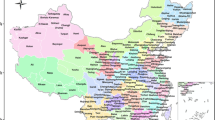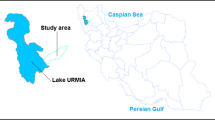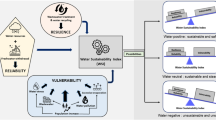Abstract
Sustainable management of water resources is an essential process for securing Earth’s present and future generation life. This study offers development of a new comprehensive framework and index for socio-economic evaluation of water resource systems. The hydro-socio-economic index (HSEI) is made of several economic, demographic, technology and communication, and health and sanitation factors at different temporal and spatial scales. The major foci of this research are estimation of HSEI and the analysis of their socio-economic situation of those European countries with increasing renewable water per capita during 1998–2017 periods. The HSEI values for all of the studied European countries range from 0.480 to 0.521 based on the single and combined methods. According to the qualitative classification, the index values are classified in good level for all fourteen countries. The results show that the increase in renewable water per capita influences socio-economic parameters in those countries. The result of this study will further support future investigation of selecting underlying factors that can be used as a criterion for the future planning and decision-making processes to form sustainable policies.











Similar content being viewed by others
Data availability
All of the required data have been presented in our article.
References
Adger, W. N. (2003). Social capital, collective action, and adaptation to climate change. Economic Geography, 79(4), 387–404.
Aerts, J. C. J. H., Botzen, W. J., Clarke, K. C., Cutter, S. L., Hall, J. W., Merz, B., et al. (2018). Integrating human behavior dynamics into flood disaster risk assessment. Nature Climate Change, 8, 193–199.
AghaKouchak, A., Feldman, D., Hoerling, M., Huxman, T., & Lund, J. (2015). Water and climate: Recognize anthropogenic drought. Nature News, 524(7566), 409.
Baliuk, S., Medvedev, V., Kucher, A., Solovey, V., Levin, A., & Kolmaz, Y. (2017). Ukrainian chernozems as a factor in global food security and resilience of agriculture to climate change. In Global symposium on soil organic carbon, Rim, Italija.
Bozorg-haddad, O., Solgi, M., & Loaiciga, H. A. (2017). Meta-heuristic and evolutionary algorithms for engineering optimization. New York: Wiley.
Brooks, N., Adger, W. N., & Kelly, P. M. (2005). The determinants of vulnerability and adaptive capacity at the national level and the implications for adaptation. Global Environment Chang Part A, 15(2), 151–163.
Bui, N. T., Kawamura, A., Amaguchi, H., Du Bui, D., Truong, N. T., & Nakagawa, K. (2018). Social sustainability assessment of groundwater resources: A case study of Hanoi, Vietnam. Ecological Indicators, 93, 1034–1042.
Carey, M., Baraer, M., Mark, B. G., French, A., Bury, J., Young, K. R., et al. (2014). Toward hydro-social modeling: Merging human variables and the social sciences with climate-glacier runoff models (Santa River, Peru). Journal of Hydrology, 518, 60–70.
Cutter, S. L., Boruff, B. J., & Shirley, W. L. (2003). Social vulnerability to environmental hazards. Social Science Quarterly, 84(2), 242–261.
Cutter, S. L., Mitchell, J. T., & Scott, M. S. (2000). Revealing the vulnerability of people and places: A case study of Georgetown County, South Carolina. Annals of the Association of American Geographers, 90(4), 713–737.
De Oliveira Mendes, J. M. (2009). Social vulnerability indexes as planning tools: Beyond the preparedness paradigm. Journal of Risk Research, 12(1), 43–58.
Dean, A. J., Fielding, K. S., Lindsay, J., Newton, F. J., & Ross, H. (2016). How social capital influences community support for alternative water sources. Sustainable Cities and Society, 27, 457–466.
Diaz, M. E., Figueroa, R., Alonso, M. L. S., & Vidal-Abarca, M. R. (2018). Exploring the complex relations between water resources and social indicators: The Biobío Basin (Chile). Ecosystem Services, 31, 84–92.
Diep, L. (2018). The liquid politics of an urban age. Palgrave Communications, 4(1), 76.
Dwyer, A., Zoppou, C., Nielsen, O., Day, S., & Roberts, S. (2004). Quantifying social vulnerability: A methodology for identifying those at risk to natural hazards. Geoscience Australia, 14, 1417–1428.
El-Gafy, I. K. E. D. (2018). The water poverty index as an assistant tool for drawing strategies of the Egyptian water sector. Ain Shams Engineering Journal, 9(2), 173–186.
Fawell, J., & Nieuwenhuijsen, M. J. (2003). Contaminants in drinking water environmental pollution and health. British Medical Bulletin, 68(1), 199–208.
Ferreira, C. (2006). “Gene expression programming: mathematical modeling by an artificial intelligence (Vol. 21). Berlin: Springer.
Forouzani, M., Karami, E., Zamani, G. H., & Moghaddam, K. R. (2013). Agricultural water poverty: Using Q-methodology to understand stakeholders’ perceptions. Journal of Arid Environments, 97, 190–204.
GDP—composition, by sector of origin. Retrieved March 19, 2018.
Global 500—Countries: Hungary—Fortune. Money 23 July 2012. Retrieved June 10, 2013.
Goharian, E., Burian, S. J., & Karamouz, M. (2017). Using joint probability distribution of reliability and vulnerability to develop a water system performance index. Journal of Water Resources Planning and Management, 144(2), 04017081.
IMF World Economic Outlook Database. (2011). Central and Eastern Europe. Archived from the original on 15 October 2011. Retrieved April 27, 2011.
Jongman, B. (2018). Effective adaptation to rising flood risk. Nature Communications, 9(1), 1986.
Karunanithi, N., Grenney, W. J., Whitley, D., & Bovee, K. (1994). Neural networks for river flow prediction. Journal of Computing in Civil Engineering, 8(2), 201–220.
Khan, S. (2012). Vulnerability assessments and their planning implications: A case study of the Hutt Valley, New Zealand. Nature Hazards, 64, 1587–1607.
Kotzee, I., & Reyers, B. (2016). Piloting a social-ecological index for measuring flood resilience: A Composite Index approach. Ecological Indicators, 60, 45–53.
Lannin, P., & Braslina, A. (2010). UPDATE 2-IMF hails Latvia effort but sees risks ahead. Reuters, 15 March 2010. Retrieved July 31, 2010.
Lee, Y. J. (2014). Social vulnerability indicators as a sustainable planning tool. Environmental Impact Assessment Review, 44, 31–42.
Li, C., Feng, W., Song, F., He, Z., Wu, F., Zhu, Y., et al. (2019). Three decades of changes in water environment of a large freshwater Lake and its relationship with socio-economic indicators. Journal of Environmental Sciences, 77, 156–166.
Liang, L., Lal, R., Ridoutt, B. G., Zhao, G., Du, Z., Li, L., et al. (2018). Multi-indicator assessment of a water-saving agricultural engineering project in North Beijing, China. Agricultural Water Management, 200, 34–46.
Lietuvos makroekonomikos apžvalga. nr. 62. SEB. (2014). Retrieved September 7 2016.
Lima, J. M. T., Valle, D., Moretto, E. M., Pulice, S. M. P., Zuca, N. L., Roquetti, D. R., et al. (2016). A social-ecological database to advance research on infrastructure development impacts in the Brazilian Amazon. Scientific Data, 3, 160071.
Montaseri, M., Ghavidel, S. Z. Z., & Sanikhani, H. (2018). Water quality variations in different climates of Iran: Toward modeling total dissolved solid using soft computing techniques. Stochastic Environmental Research and Risk Assessment, 32(8), 2253–2273.
Nutrition, Physical Activity and Obesity Albania. (2013). euro.who.int. p. 3.
Ojerio, R., Moseley, C., Lynn, K., & Bania, N. (2011). Limited involvement of socially vulnerable populations in federal programs to mitigate wildfire risk in Arizona. Natural Hazards Review, 12(2), 28–36.
Pande, S., & Sivapalan, M. (2017). Progress in sociohydrology: A metaanalysis of challenges and opportunities. Wiley Interdisciplinary Reviews: Water, 4(4), e1193.
PAP. (2013). Polska żywność—Fundament polskiego eksportu, 2012 kolejnym rokiem rekordowego eksportu żywności.” Ministerstwo Skarbu Państwa (Internet Archive).
Polsky, C., Neff, R., & Yarnal, B. (2007). Building comparable global change vulnerability assessments: The vulnerability scoping diagram. Global Environmental Change, 17, 472–485.
Popovic, T., Kraslawski, A., Heiduschke, R., & Repke, J. (2014). Indicators of social sustainability for wastewater treatment processes. Computer Aided Chemical Engineering, 34, 723–728.
Prihodi, U. (2017). najbolje pokazuju napredak hrvatskog turizma [Revenue in 2017 show best Croatian tourism’s progress]. hr.n1info.com (in Croatian). N1. 30 March 2018. Retrieved April 22, 2018.
Public Information Notice (PIN). (2012). No. 12/76 by IMF. IMF executive board concludes first post-program monitoring discussions with the Republic of Latvia. July 16, 2012. imf.org. Retrieved July 18, 2012.
Research and development (R&D): Gross domestic spending on R&D—OECD Data. data.oecd.org. Retrieved February 10 2016.
Roboredo, D., Bergamasco, S. M. P. P., & Bleich, M. (2016). Aggregate Index of social-environmental sustainability to evaluate the social-environmental quality in a watershed in the Southern Amazon. Ecological Indicators, 63, 337–345.
Schmidtlein, M. C., Shafer, J. M., Berry, M., & Cutter, S. L. (2011). Modeled earthquake losses and social vulnerability in Charleston, South Carolina. Applied Geography, 31, 269–281.
Seidl, R., & Barthel, R. (2017). Linking scientific disciplines: Hydrology and social sciences. Journal of Hydrology, 550, 441–452.
Strategy of Science, Technology and Innovation 2009–2015. Retrieved August 27, 2010.
Tate, E., Cutter, S. L., & Berry, M. (2010). Integrated multihazard mapping. Environment and Planning B: Planning and Design, 37, 646–663.
The economies of Bulgaria and Romania. European Commission. Retrieved December 20, 2011.
Tunstall, S., Tapsell, S., & Fernandez-Bilbaoet, A. (2007). Vulnerability and flooding: A re-analysis of FHRC data. London: European Community.
Vollmer, D., Shaad, K., Souter, N. J., Farrell, T., Dudgeon, D., Sullivan, C. A., et al. (2018). Integrating the social, hydrological and ecological dimensions of freshwater health: The Freshwater Health Index. Science of the Total Environment, 627, 304–313.
Watkins, T. (2014). Economic history and the economy of Hungary. sjsu.edu. San José State University Department of Economics. Retrieved August 6, 2014.
Wilson, M., Li, X. Y., Ma, Y. J., Smith, A., & Wu, J. (2017). A review of the economic, social, and environmental impacts of China’s South-North Water Transfer Project: A sustainability perspective. Sustainability, 9(8), 1489.
World Bank Country Classification. (2008). Archived from the original on 24 May 2008. Retrieved September 30, 2014.
Acknowledgements
The authors thank Iran’s National Science Foundation (INSF) for its financial support of this research.
Author information
Authors and Affiliations
Corresponding author
Ethics declarations
Conflict of interests
The authors declare that they have no conflict of interest.
Additional information
Publisher's Note
Springer Nature remains neutral with regard to jurisdictional claims in published maps and institutional affiliations.
Rights and permissions
About this article
Cite this article
ZamanZad-Ghavidel, S., Bozorg-Haddad, O. & Goharian, E. Sustainability assessment of water resource systems using a novel hydro-socio-economic index (HSEI). Environ Dev Sustain 23, 1869–1916 (2021). https://doi.org/10.1007/s10668-020-00655-8
Received:
Accepted:
Published:
Issue Date:
DOI: https://doi.org/10.1007/s10668-020-00655-8












